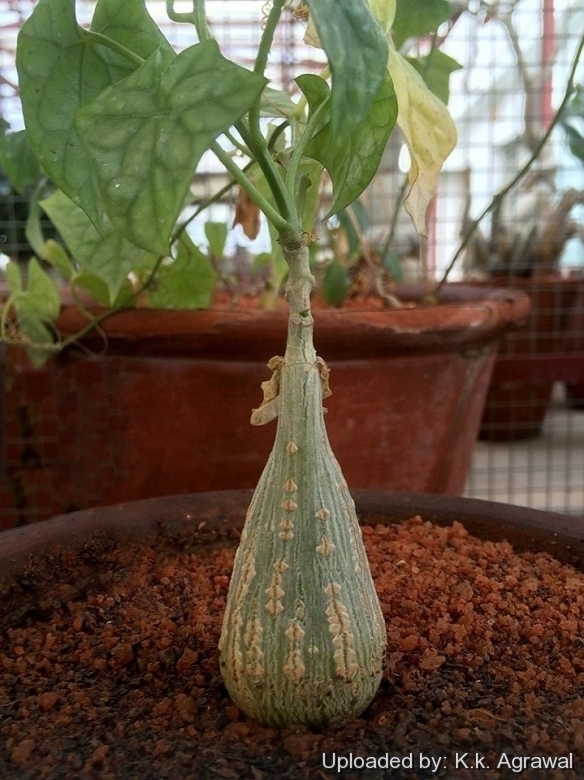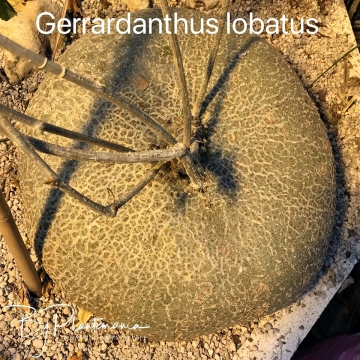Accepted Scientific Name: Gerrardanthus lobatus (Cogn.) C.Jeffrey
Kew Bull. 15: 353 1962

Gerrardanthus grandiflorus var. lobatus (Gerrardanthus lobatus) Photo by: K.k. Agrawal
Origin and Habitat: Nigeria, Uganda, Kenya, Tanzania, Malawi.
Altitude range: From near sea level to 200 metres above sea level.
Habitat and ecology: Gerrardanthus lobatusSN|28257]]SN|28257]] grows in deciduous bushland, woodland, wooded grassland in rocky places, and also in hygrophilous and riverine forests and clearings.
Synonyms:
Description: Gerrardanthus lobatusSN|28257]]SN|28257]] is a perennial herbaceous climber relative of the cucumber with 6 m long stems expanded at base into an enormous semi-subterranean water storing rootstock (caudex). Flowers brownish-orange.
Caudex: Exposed, dome-shaped to more than 50 cm in diameter, greenish.
Stems: Scandent up to 6 m long, semi-succulent becoming rather woody when old, with smooth greyish bark.
Leaves: Ovate to reniform-cordate, 3 - 10 cm long, 4.4 - 12.4 cm wide, usually deeply 5-lobed, lobes triangular, shortly acuminate, slightly fleshy, somewhat glaucous, glabrous. Petiole 1.5-8 cm long.
Tendrils: Apically 2-fid.
Male flowers: Few to 45 in 2-10 cm long panicles on 02-15 mm long peduncles. Pedicels 2-20 mm long, hypanthium shallow, lobes 2 - 4 mm, Petals 5, brownish-green or dull brownish-orange or pinkish, unequal, 2 erect, oblanceolate. Stamens 5 of which 4 connate by the anthers into two pairs and the fifth (unpaired) stamen represented by a subulate staminode.
Female flowers: Solitary or in small groups on 15–30 mm long peduncles. Pedicels 1–8 mm. Long. Ovary 7–10 mm long, 2–3 mm in diameter. Receptacle-lobes ovate-lanceolate, 2–2.5 mm. Long. Petals unequal, 3 broad, erect, 8–10 mm long, 2–2.5 mm broad, 2 oblong, erect, spreading or reflexed, 7–8 mm long, 1 mm broad the three smaller 9–16 mm. long, linear, much narrower, reflexed, paler.
Fruit: Obconic-cylindric, 3-sided, glabrous, smooth, obscurely veined, 45–63 mm. long, 18–28 mm across the faces dehiscing by an apical slit, ripening pale yellow. Peduncle 14–62 mm long. Pedicels 1–15 mm long.
Seeds: 1-3 in a cluster, fusiform, with a broad somewhat asymmetrically inserted wing, the body of the seed to 2.5-4.5 cm long, with the body of the seed 1.2–2.2 cm long, 1.8–3.5 mm across and the wing 14–22 mm long.
Bibliography: Major references and further lectures
1) Urs Eggli “Illustrated Handbook of Succulent Plants: Dicotyledons” Springer Science & Business Media, 2002
2) Klaus Kubitzki “Flowering Plants. Eudicots: Sapindales, Cucurbitales, Myrtaceae” Springer Science & Business Media, 10/Dec/2010
3) C. Jeffrey “Flora of Tropical East Africa” 1967
4) C. Jeffrey “Flora Zambesica”, Vol 4 Part 0, page 414 1978
5) Takhtajan, A., “Diversity and Classification of Flowering Plants” Columbia University Press : New York, 1997
 Gerrardanthus grandiflorus var. lobatus (Gerrardanthus lobatus) Photo by: © Plantemania
Gerrardanthus grandiflorus var. lobatus (Gerrardanthus lobatus) Photo by: © Plantemania Gerrardanthus grandiflorus var. lobatus (Gerrardanthus lobatus) Photo by: © Plantemania
Gerrardanthus grandiflorus var. lobatus (Gerrardanthus lobatus) Photo by: © Plantemania Gerrardanthus lobatus - 3 months old seedling. (Gerrardanthus lobatus) Photo by: Valentino Vallicelli
Gerrardanthus lobatus - 3 months old seedling. (Gerrardanthus lobatus) Photo by: Valentino VallicelliSend a photo of this plant.The gallery now contains thousands of pictures, however it is possible to do even more. We are, of course, seeking photos of species not yet shown in the gallery but not only that, we are also looking for better pictures than those already present.
Read More... Cultivation and Propagation: It grows well, though very slowly, but it possible to increase the speed of growth to some extent by providing adequate amount of water, warmth, and fertilizer during the active growing season, but it’s susceptible to rotting if too wet. It likes a sunny position, but avoid direct blasting sun in summer. It should be watered regularly in Summer and kept drier in Winter. It like pots with generous drain holes, need a very porous, slightly acidic potting medium (add pumice, vulcanite, and perlite). It can be grown outdoors in frost-free climates, need anyway to kept above 0°C and dry in winter.
Maintenance: Repot every two years.
Propagation: Seeds or cuttings.













